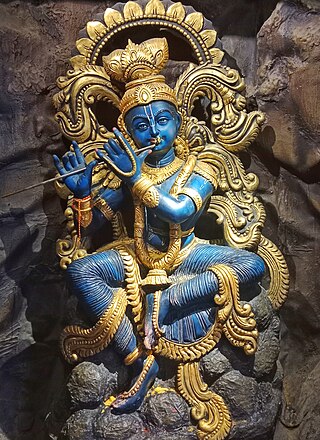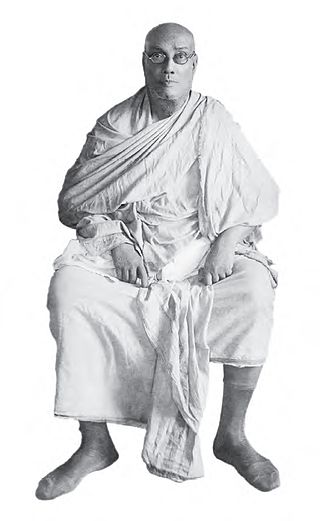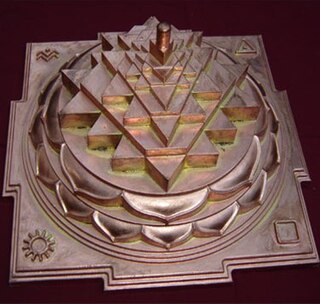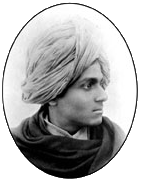
Hari is among the primary epithets of the Hindu preserver deity Vishnu, meaning 'the one who takes away' (sins). It refers to the one who removes darkness and illusion, the one who removes all obstacles to spiritual progress.

Krishna Dvaipayana, better known as Vyasa or Vedavyasa, is a revered sage portrayed in most Hindu traditions. He is traditionally regarded as the author of the epic Mahabharata.

Govinda, also rendered Govind and Gobind, is an epithet of Vishnu and is also used for his avatars such as Krishna. The name appears as the 187th and the 539th name of Vishnu in the Vishnu Sahasranama. The name is also popularly addressed to Krishna, referring to his youthful activity as a cowherd boy.

Swami Prabhavananda was an Indian philosopher, monk of the Ramakrishna Order, and religious teacher. He moved to America in 1923 to take up the role of assistant minister in the San Francisco Vedanta Society. In 1928 he was the minister of a small group in Portland, OR, but in 1930 he founded the Vedanta Society of Southern California. The Swami spent the rest of his life there, writing and collaborating with some of the most distinguished authors and intellectuals of the time, including Aldous Huxley, Christopher Isherwood, and Gerald Heard.

The Vishnu Sahasranama, is a Sanskrit hymn containing a list of the 1,000 names of Vishnu, one of the main deities in Hinduism and the Supreme God in Vaishnavism. It is one of the most sacred and popular stotras in Hinduism. The Vishnu Sahasranama is featured in the Anushasana Parva of the epic Mahabharata. Other versions exist in the Padma Purana, the Skanda Purana, and the Garuda Purana. There is also a Sikh version of the Vishnu Sahasranama found in the work Sundar Gutka.
Swami Gambhirananda (1899–1988), born as Jatindranath Datta, was a Hindu sanyasi associated with Ramakrishna Mission. He was born at Sadhuhati in today's Bangladesh. He graduated from Scottish Church College, Calcutta (Kolkata).

In Hinduism, Achyutatransl. "the infallible one" is an epithet of Vishnu and appears as the 100th and 318th names in the Vishnu Sahasranama. It is also often used in the Bhagavad Gita as a personal name of Krishna. According to Adi Shankara's commentary on the 1000 Names of Vishnu, Achyuta means "one who will never lose his inherent nature and powers". The name also means "immovable", "unchangeable", and as such is used for "the one who is without the six transformations, beginning with birth".

Swami Vijnanananda was an Indian monk of Ramakrishna order, born in an upper-class family near Dakshineswar, and was a direct disciple of Ramakrishna. He was an engineer and worked as the District Engineer in the erstwhile State of United Provinces, India. He was a great scholar of Sanskrit with expertise in religio-philosophical works, astronomy, civil engineering etc. He spent considerable time in Allahabad (Prayag) centre of Ramakrishna Math. He became the President of Ramakrishna Mission in 1937. It was under his presidency and direct supervision that the Ramakrishna Temple at Belur Math was constructed and consecrated.
Swami Vireshwarananda, the tenth President of the Ramakrishna Math and Ramakrishna Mission, was born on 31 October 1892 at Gurupura, Near Mangalore, South India. His pre-monastic name was Pandurang Prabhu; he was later known as Prabhu Maharaj. After his father's death at an early age, his mother moved with them to his maternal uncle's house at Mangalore.

Swami Yatiswarananda was a vice-president of Ramakrishna Order, whose headquarter is in Belur Math. He was a disciple of Swami Brahmananda, a brother disciple of Swami Vivekananda and a direct disciple and spiritual son of Ramakrishna. He served in Philadelphia propagating the message of Vedanta. He was the president of Bangalore centre of Ramakrishna Math. He founded an ashrama in Switzerland.

Ramakrishna Math is the administrative legal organization of the Ramakrishna Order, considered part of the Hindu reform movements. It was set up by sanyasin disciples of Ramakrishna Paramhansa headed by Swami Vivekananda at Baranagar Math in Baranagar, a place near Calcutta, in 1886. India. The headquarters of Ramakrishna Math and its twin organisation, Ramakrishna Mission is at Belur Math.

The Soundarya Lahari meaning "The waves of Beauty" is a famous literary work in Sanskrit attributed to Adi Shankara. Some believe the first part "Ananda Lahari" was etched on mount Meru by Ganesha himself. Sage Gaudapada, the teacher of Shankar's teacher Govinda Bhagavadpada, memorised the writings of Pushpadanta which was carried down to Adi Shankara. Its hundred and three shlokas (verses) praise the beauty, grace and munificence of Goddess Tripura Sundari as Goddess Parvati. W. Norman Brown translated it to English which was published as volume 43 of the Harvard Oriental Series in 1958.

Madhava is one of the primary epithets of Vishnu and Krishna. The word Mādhava in Sanskrit is a vṛddhi derivation of the word Madhu, which means honey. It is a title of Krishna, referring to his lineage as 'he who appeared the Madhu dynasty'.
Swami Chidbhavananda was born in Senguttaipalayam near Pollachi in Coimbatore District, Madras Presidency, India. His parents named him 'Chinnu'. He studied in Stanes School, Coimbatore. He was one of the two Indians in his class, the rest being British. His parents wanted him to go to England after completing his degree in Presidency College, Chennai.

Shivananda Lahari is a devotional hymn composed by Adi Shankara, Advaita philosopher, on Shiva. It literally means Wave of Auspicious Bliss. It consists of one hundred stanzas of Sanskrit poetry in various chandas (metres). It was composed by Adi Shankara while staying in Srisailam, a pilgrimage town, in Kurnool district of Andhra Pradesh. It begins with an ode to Mallikarjuna and Bhramarambika, the deities at Srisailam.

Paramananda (1884–1940) was a swami and one of the early Indian teachers who went to the United States to spread the Vedanta philosophy and religion there. He was a mystic, a poet and an innovator in spiritual community living.

Shri Vidya is a Hindu Tantric religious system devoted to the Goddess as Lalitā Tripurasundarī.

Swarupananda was a direct monastic disciple of Vivekananda and the first president of the Advaita Ashrama, set up by Vivekananda in 1899 at Mayavati, near Champawat. The ashram is a branch of the religious monastic order, Ramakrishna Math, also set up by Vivekananda on the teachings of his guru Ramakrishna.

Sri Ramakrishna Math, Chennai is a monastic organisation for those men who were taught into existence by Sri Ramakrishna (1836–1886), a 19th-century saint of Bengal. The motto of the Ramakrishna Math and Ramakrishna Mission is: "For one's own salvation, and for the welfare of the world". The math in Chennai is the first branch center of the Ramakrishna Order in Southern India. It was established in 1897 by Swami Ramakrishnananda, one of the direct disciples of Sri Ramakrishna. Besides Swami Ramakrishnananda, the Math was visited by Holy Mother Sri Sarada Devi, Swami Nirmalananda, Swami Shivananda, Swami Abhedananda, Swami Premananda, Swami Niranjanananda, Swami Trigunatitananda, and Swami Vijnanananda.

In Hinduism, the first guru of the Nimbarka Sampradaya is Sri Hansa Bhagwan, who is regarded one of the twenty-four incarnations of Vishnu within the tradition. At the beginning of creation, in the Satya Yuga, Vishnu Himself took the form of a quadrangle, joined conch shells, chakras, maces, and lotuses, and descended to the sage Sankadi, the son of Brahma, in the name of Hansabata.
















